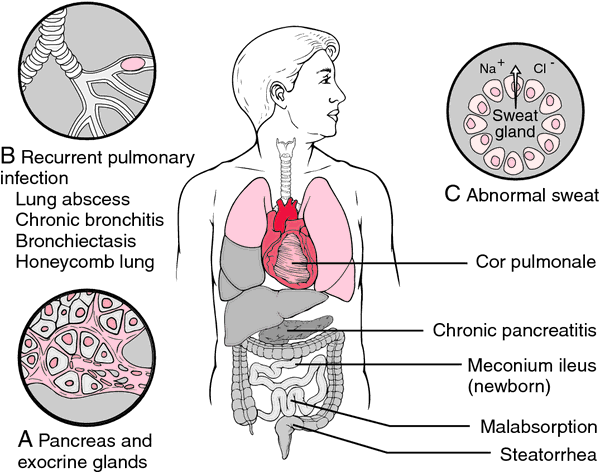Medical term:
cystic
cystic
[sis´tik]In the lungs, the mucus blocks the bronchioles, creating breathing difficulties. Infection develops, thereby increasing obstruction of the air passages. Air becomes trapped in the lungs (emphysema), and scattered small areas eventually collapse (patchy atelectasis). Repeated infections follow, inflaming and damaging lung tissue and leading to chronic lung disease. The organism that produces infection in cystic fibrosis is almost always a staphylococcus, but other organisms may be present in more severe cases. About half of children with cystic fibrosis have lung-related symptoms.
When mucus prevents the pancreatic enzymes from reaching the duodenum (as in about 80 per cent of cystic fibrosis patients), digestion is hindered. Fats especially are poorly digested and absorbed. The child may have a voracious appetite, yet fail to grow normally or gain weight. There may be marked signs of malnutrition. The outstanding symptom associated with pancreatic enzyme deficiency is frequent bulky, fatty, and foul-smelling feces.
Between 5 and 10 per cent of cystic fibrosis babies are born with intestines obstructed by puttylike intestinal secretions (meconium ileus) and die unless the condition is diagnosed promptly and relieved by surgery within the first few days of life. Such relief does not protect the child against the other manifestations of cystic fibrosis, although these may not appear until later.
Because cysts and scar tissue on the pancreas were observed during autopsy when the disease was first being differentiated from other conditions, it was given the name cystic fibrosis of the pancreas. Although this term describes a secondary rather than primary characteristic, it has been retained.
It is estimated that in the United States cystic fibrosis occurs once in every few thousand births. Caucasians appear more subject to it than blacks, and among those of Asian descent it seems to be rare.
Skin care is important, especially for infants and toddlers who are not yet toilet trained. The stools are likely to be copious and extremely irritating to the skin. Frequent turning of the infant or bedridden child helps to prevent decubitus ulcers and lessens the danger of pneumonia, a constant threat to these children. Prevention of infection is a most important aspect of the care of these children because of their extreme vulnerability to disorders of the respiratory tract.
Education of the parents must include the dietary regimen; how to use the Croupette, a machine for aerosol therapy in the home; hygienic measures to prevent infections; and the importance of continuous medical follow-up and administration of medications prescribed for the child.

cys·tic
(sis'tik),cystic
(sĭs′tĭk)cys·tic
(sis'tik)cystic
AdjPatient discussion about cystic
Q. Can cystic fibrosis patients have children? My boyfriend has cystic fibrosis, and currently he’s treated with many medications but usually healthy (other than pneumonia from hospitalization from time to time). I heard that men with cystic fibrosis can’t have children - is that true? Is there anything he can do about it?
I'M SO SORRY ABOUT MY ENGLISH, I'M LEARNING.
Q. Do women with cystic fibrosis have difficult pregnancy? My wife has cystic fibrosis, and after 3 year of marriage we decided we want a baby. I know that men with cystic fibrosis are usually infertile and can’t have children- is that the case also for women with cystic fibrosis? Is the pregnancy in women with cystic fibrosis more problematic? Is it dangerous?
Q. My daughter has a cystic mygroma. Has anyone else had this or know anyone who has, and how did you treat it? I really need some help on this issue, she has it in her neck and they say they shouldn't opperate because it may come back. I hope that someone out here can help me.
ask your Doctors about them.
- cystic
- Cestica
- Cistic
- Mystica
- Suastica
- Sustac
- Svastika
Latest Searches:
vagabonds' - VAG - vadum - VADs - Vademin - VAD - vacuus - vacuum - vacuome - vacuolization - vacuoles - vacuole - vacuolating - vacuolated - vacuolate - vacuolar - vacuo - Vaculance - VACTERL - Vacora -
- Service manuals - MBI Corp